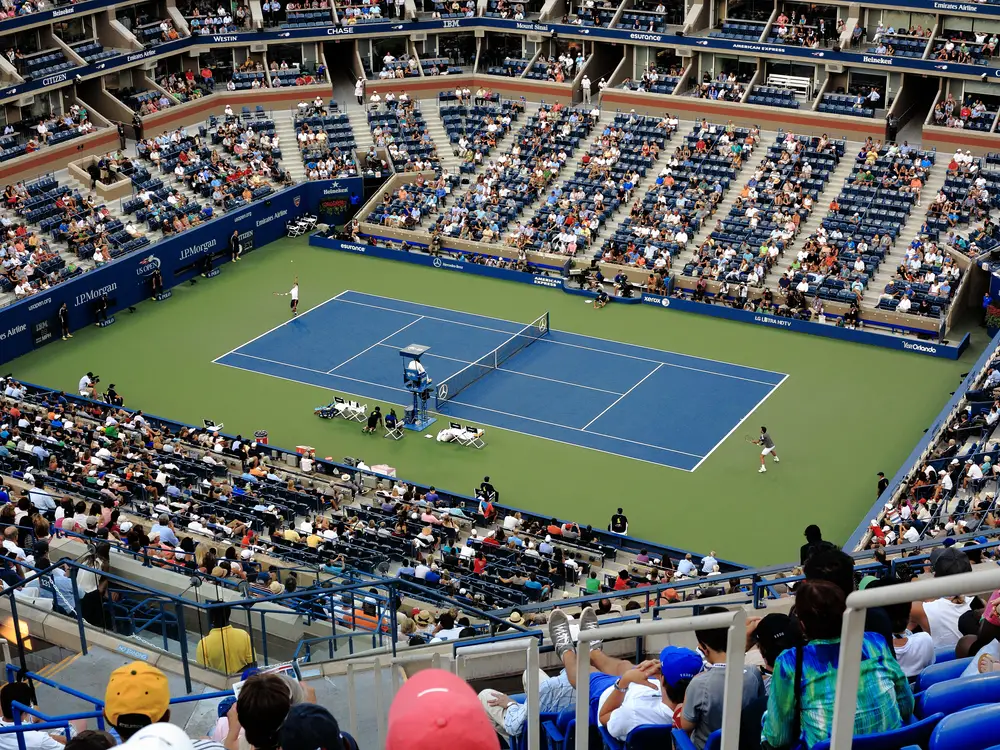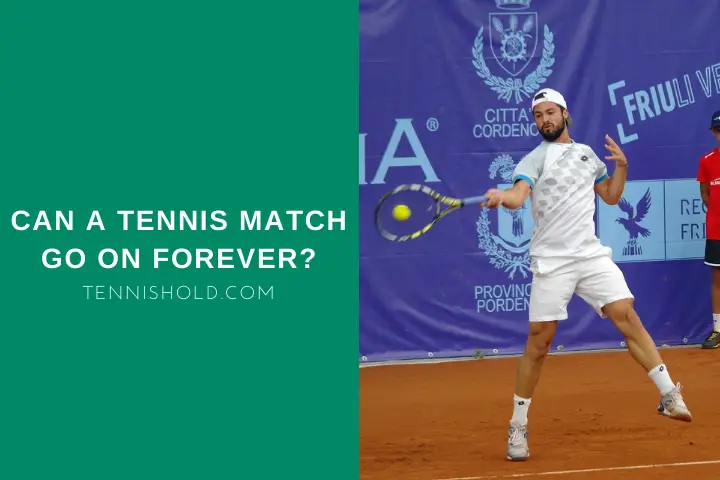Today, the standard procedure in tennis, when the score in a set is 6-6, is to play a tiebreak to 7 points. However, this has not always been the case.
Even in 1968, the year the open era began, tiebreaks were not used in matches.
There was no provision for a tie, and thus matches would be played until one player took at least 6 games while being 2 in front of their opponent.
Is it possible for a tennis match today to go on forever?
If a match is played with standard deuce scoring, the match can go on forever. Since 2019, Rolland Garros (French Open) has been the only tournament not to feature a tiebreak in the final set. It is thus most likely here that you will see a never-ending match.
If you play tennis yourself, you will know how often you can end up going back and forwards between deuce and advantage. You may at times wonder if it will go on forever.
In this article I will be discussing:
- How long a set of tennis lasts
- Rules regarding match time in tennis
- The longest matches in tennis history
This is going to be an interesting article, so I hope you stick around!
How Long Does A Tennis Set Last?

The average set of tennis will last between 30 and 45 minutes. This is assuming that the scoring system is a standard set to 6 with 2 games clear.
In other words, when you get 6 games, you are at least two in front of your opponent.
This can be even quicker if you play a match with sudden death deuce scoring. In this scenario, when the score is 40-40, the following point wins the game.
When playing with the sudden death format, the returner can decide which side to receive the ball.
With sudden death scoring and tiebreak at 6-6, it is almost impossible for the match to go on forever.
Theoretically, it could go on forever if no one wins by two points in the tiebreak.
Another system used to speed up matches is short sets. Short sets work the same as standard sets.
The only difference is that instead of needing a minimum of 6 games to win, you need 4. Shorts set last on average 20-25 minutes.
Short sets can also be played both with and without deuce. Short sets are usually used at junior and amateur adult events.
The final scoring format I will talk about is FAST4.
FAST4 was launched to provide an exciting way to speed up matches. There are slight variations in how FAST4 is used across the world.
Traditional features of FAST4 sets are:
- Sudden death deuce
- Tiebreak at 3-3
- Tiebreak is played to 5 points instead of 7
- Sudden death if the tiebreak reaches 4-4
- No let. Meaning if the serve hits the net and goes in, play continues
The average time for a FAST4 set is similar to a short set. The rules are very alike and if the match doesn’t go to tiebreak, the difference isn’t much.
Are There Any Rules On The Length Of The Match?

There are no rules that set a limit on how long a tennis match can last. There are, however, some countries that allow a timed match format.
In this case, a match would last, for example, 20 minutes. Whichever player has the most games after the time runs out wins.
This is an unpopular system that is rarely used.
None of the main methods used today are designed to completely prevent a match from going on forever.
They are used to reduce the chance of it happening. But, at the same time, the formats preserve the traditional scoring system as much as possible.
Time violations are another way of reducing the risk of a never-ending match. Players will have either 20 or 25 seconds to serve, depending on the tournament they are playing.
More professional tournaments feature a countdown clock today than ever before. This clock shows how many seconds the player has to serve before receiving a time violation.
Even though the introduction of the serve clock was designed to speed up matches, it has had some side effects.
Elina Svitolina, World number 6 at the time of writing, described the serve clock as cool. Svitolina says that she is so quick to serve that seeing 15 seconds to go on the clock encourages her to use more time.
Svitolina says that she uses the remaining time to think about what she is going to do.
Until 2019, the US Open was the only grand slam to use a tiebreak in the 5th set. This meant that at Wimbledon, Rolland Garros, and the Australian Open, there was no limit on the number of games that could be played in the final set.
In 2019, Wimbledon introduced a final set tiebreak. Instead of the tiebreak being triggered at 6-6, it takes place at 12-12. The other sets still go to tiebreak when the score reaches 6-6.
Also, in 2019, the Australian Open introduced a tiebreak in the final set. When the score equals 6-6, a super tiebreak to 10 points is played. The 10-point tiebreak works the same as a regular tiebreak. The only difference is that to win, you need a minimum of 10, not 7.
It is not surprising to learn that the longest match of all time took place at one of these tournaments, with a no tie break final set.
What Was The Longest Tennis Match?

The longest tennis match in history (number of games played and time taken) was in the 1st round of Wimbledon 2010. Over 3 days, American John Isner defeated Frenchman Nicolas Mahut, 6-4, 3-6, (7)6-7, 7-6(3), 70-68. The match lasted 11 hours and 5 minutes.
The reason it lasted so long is simple. Neither of the two players could win more than two games in a row in the final set.
Without a tiebreak, they had no option but to play on. Eventually, Isner broke serve and thus had a 2-game lead. He therefore won.
This incident perfectly illustrates the advantage of serving first in tennis. As Isner served first in the final set, he just needed to break Mahut to win. For Mahut to win, he would need to have broken serve and then hold.
When players are unable to break each other’s serves, the matches go on for longer. There were no breaks of serve in the third and fourth sets. As there were tiebreaks, it prevented these sets from going on for longer than they did.
The fifth set didn’t have a tiebreak. Instead, it continued until Isner took the two-game lead at 70-68.
Isner wasn’t just involved in the longest match in Wimbledon history. He was also the second-longest. This time on the losing end.
In his 2018 Wimbledon semi-final, he was defeated by South African Kevin Anderson, 7-6(6), (5)6-7, (9)6-7, 6-4, 26-24. The match lasted 6 hours and 36 minutes.
This match, along with Anderson’s quarter-final against Federer, is arguably why Wimbledon introduced a 5th set tiebreak.
Anderson won his quarter-final against Federer 13-11 in the 5th set. Even though Anderson made it to the final, he underperformed and was no match for Djokovic.
It’s safe to say Anderson was exhausted by the time he made the final. In his semi and quarter-finals alone, he played 166 games. In Djokovic’s semi and quarter-final matches, he played 93 games. That is still a lot but way less than Anderson.
Following the match, both Isner and Anderson agreed that it was time to introduce a final set tiebreak. This was the last year that Wimbledon was held without a final set tiebreak.
Final Words
It seems that the days of never-ending final sets are on their way out. However, I think it is just a matter of time before the French open introduces it.
Even though a match can go on forever with a tiebreak, the odds of it happening are slim.
Do you think Wimbledon and the Australian Open made the right decision switching to a final set tiebreak? I understand the reasons, but I do love the idea of the never-ending final set.

